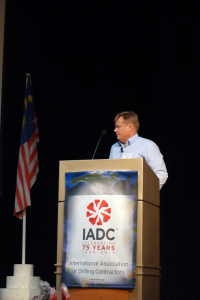Panel: Embedding safety culture requires creative, integrated approach
By Astrid Wynne, Contributing Editor

Safety culture is all about human behavior, how people communicate and how leaders lead, Rosli Hamzah, Head of International Wells at PETRONAS, said in moderating a panel discussion at the 2015 IADC Drilling HSE&T Asia Pacific Conference on 11 March in Kuala Lumpur. Panelists – representing Dynamic Drilling, Check-6, Mission Excellence and Shell – agreed that soft skills are vital when attempting to implement sustainable changes in culture.
Gregg O’Neill, VP QHSE at Dynamic Drilling, outlined an approach that makes the message very personal for crews. “One size does not fit all. Be prepared to step out of the comfort zone to get realization and involvement,” he advised. He drew a distinction between passive learning, which is at the narrow end of the effectiveness pyramid, and active learning, like such as discussion, practice and teaching others. Citing personal experience, he emphasized the importance of understanding people, the systems they use and the problems they encounter – that is the starting point to reach people in a way they truly appreciate and understand. “Once you have a safety system that gets people involved, making a change is much, much simpler,” he explained.
According to Rob Adlam, Check-6 Client Manager, more than 80% of recordable incidents are directly related to human behavior: poor communication; little or no management of change; little or no supervision; and standards and procedures not being followed. Of these behavior-related problems, failure to follow standards and procedures accounted for the largest share of incidents. He urged companies to focus on instilling a culture of safety, where people are used to doing the right thing, as it will be inherently more effective than safety management systems on their own.
Mr Adlam also highlighted the characteristics of high-performance teams, such as individual task proficiency, clear and concise communication, team cohesion and motivation for the task. He emphasized that a safety culture is a human dynamic and characterized soft skills – like good communication and realistic appraisal – are the “glue” when instilling a culture of safety.
Justin Hughes, Managing Director of Mission Excellence, added another layer to this, saying it is impossible to engineer the risk out of drilling operations. Safety systems are an essential building block, but human decision-making will always remain a significant factor. Simulators, for example, can be useful for team-based training by playing out scenarios to help teams practice decision-making and performing under pressure.
“Repetition is a very powerful tool. Repeated use of a simulator could desensitize people and avoid panic,” he said.
Scott Dennon, Assist & Assure Team Lead at Shell, agreed that helping crews to form the right habits is of utmost importance. He highlighted ways that Shell has encouraged active participation, such as changing “toolbox talks” to “toolbox quizzes.” “A simple way of turning on the thinking brain is to ask questions. We need people to switch on their thinking brain to see the hazards and look after them. If you walk around the rig with your automatic brain on, you’ll get hurt,” he said.
All four panelists emphasized that employee involvement and the resulting culture change are dependent on a safety culture being led from the top. When management not only declares but also demonstrates a commitment to safety, real culture change can take root. As Mr Dennon said of stop-work authority: “Until the supervisor stops the job, the worker will never do it.”





I concur with most of the points highlighted above and particularly like the idea of switching on the ‘thinking brain’ during tool box talks – something we have been encouraging crews to do for some time now. When the International Oil and Gas Producers Association commissioned Critical Team Performance (CTP) to chair the industry wide stakeholder group to produce the Guidelines for Well Operations Crew Resource Management (IOGP Doc 502) training we were very conscious of nationalistic cultural barriers that can be major contributory factors in the Human Error chain developing. Having processes and checklists in dual languages is one example of how we are approaching problems with basic communication breakdowns. Leadership is key and the corporate communication messages re safety must be followed up with actions by senior management. Whilst simulator training is an excellent resource to practice non-technical skills in a safe environment the real key to achieving behavioural change is follow up work-place-based coaching. All CTP coaches working in the offshore and onshore environment achieve fantastic ‘buy-in’ from crews when they are immersed in the crews own working environment. Good luck to all who are striving to get the Human Factors message across. Phil Smith, MD, Critical Team Performance